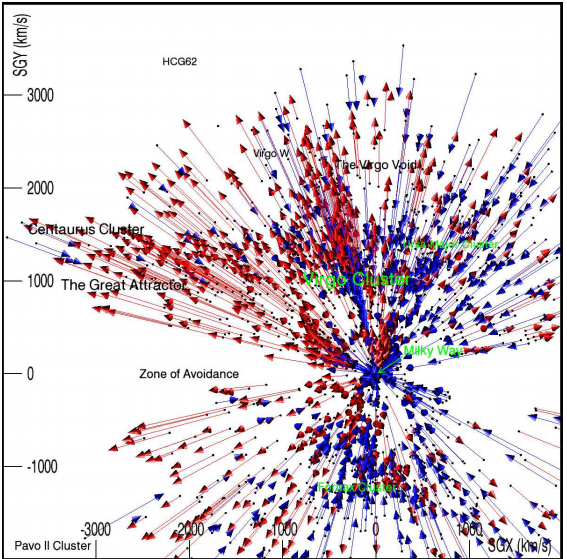New Science of Cosmography Reveals 3-D Map of the Local Universe
The geography of our world is one of the great cultural invariants. There can hardly be the person on the planet who isn’t familiar with the shape of the continents and how they dovetail together or of the Earth as a pale blue sphere orbiting the Sun with seven other planets.

Given a three-dimensional model of the solar system, almost everyone can zoom in from beyond the Oort cloud to the planet Earth and then even further to the street where they live. It is powerful shared knowledge.
But at greater distances, our geographical knowledge becomes a little blurred. Many people will have seen the extraordinary three-dimensional models of the filamentary structures that galaxies form on the larger scales in our universe.
And yet these structures remain strangely unfamiliar. Given an unlabelled three-dimensional model of this large-scale structure of the universe, who could point to the place we call home?
All that should begin to change in the next few years with the increasingly accurate maps that cosmologists are compiling of the three-dimensional distribution of galaxies within the universe.
Today, Helene Courtois at the University of Lyon in France and a few buddies show off this newfound knowledge in a movie (and accompanying paper) that they’ve created to explore the rich structure of our galactic neighbourhood.
One of the key questions that this data can help to answer is whether the distribution of visible mass in the universe is an accurate reflection of the distribution of dark matter. Courtois and co say the data shows that this is indeed the case.
The film does a fine job of showing the three-dimensional structure of this space. It also reveals the limitations of human language in describing this complex tapestry. That’s not really surprising given that our vocabulary has evolved to describe a geography that is essentially two-dimensional.
Just how to describe our position within the three-dimensional filamentary structure of the universe is a challenge that astronomers will have to wrestle with in the coming years.
And since this presents a rather different challenge than ordinary geography, researchers have coined a new term to describe this kind of intergalactic mapping–cosmography.
We can expect to see more of these kinds of 3D maps of the universe as the data becomes better and more easily accessible. And as cosmography grows into a science in its own right. Perhaps one day they will appear as familiar to us as the shape of the continents on this pale blue dot.
Ref: arxiv.org/abs/1306.0091: Cosmography Of The Local Universe
Keep Reading
Most Popular
Large language models can do jaw-dropping things. But nobody knows exactly why.
And that's a problem. Figuring it out is one of the biggest scientific puzzles of our time and a crucial step towards controlling more powerful future models.
The problem with plug-in hybrids? Their drivers.
Plug-in hybrids are often sold as a transition to EVs, but new data from Europe shows we’re still underestimating the emissions they produce.
Google DeepMind’s new generative model makes Super Mario–like games from scratch
Genie learns how to control games by watching hours and hours of video. It could help train next-gen robots too.
How scientists traced a mysterious covid case back to six toilets
When wastewater surveillance turns into a hunt for a single infected individual, the ethics get tricky.
Stay connected
Get the latest updates from
MIT Technology Review
Discover special offers, top stories, upcoming events, and more.